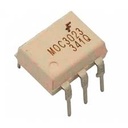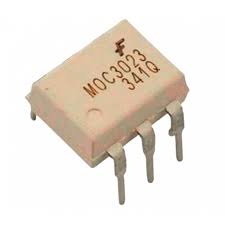MOC3023 optocoupler
This content will be shared across all product pages.
The MOC3023 is a zero-crossing optocoupler designed for interfacing low voltage control signals to high voltage loads. It includes a gallium arsenide infrared emitting diode (LED) and a silicon bilateral switch that can handle high voltages and currents. This optocoupler is commonly used in applications such as solid-state relays, lamp dimmers, and motor control systems, providing reliable isolation and control.
Key Features:
- Zero-crossing optoisolator triac driver
- High isolation voltage
- Low input current trigger levels
- High surge current capability
- Compact 6-pin DIP package
- Reliable and efficient switching
- Isolation Voltage: 7500 VRMS (1 minute)
- LED Forward Voltage: 1.2V (typical)
- LED Forward Current: 20mA (max)
- Output Peak Blocking Voltage: 400V
- Trigger Current (IFT): 5mA (max)
- Holding Current: 100µA (max)
- Operating Temperature Range: -40°C to +85°C
- Package: 6-pin DIP
- Solid-State Relays: Provides isolation and control in solid-state relay circuits for switching AC loads.
- Lamp Dimmers: Used in light dimmer circuits for smooth and efficient control of lamp brightness.
- Motor Control: Provides isolation and control in motor drive circuits for industrial and consumer applications.
- AC Load Switching: Used in circuits that require reliable switching of AC loads with electrical isolation.
- Home Appliances: Ensures safe and efficient control in various home appliances requiring AC switching.
- Industrial Automation: Provides isolation and control in industrial automation systems.
Technical Specifications:
- Logic Family: CMOS
- Number of Channels: 3
- Switch Configuration: Single-Pole Double-Throw (SPDT)
- Supply Voltage Range: 3V to 15V
- “ON” Resistance (R_ON): 125Ω typical at V_DD = 10V
- “OFF” Leakage Current (I_OFF): ±100pA typical at V_DD = 10V
- Control Input Voltage (V_IH): 0.7 V_DD min, 0.3 V_DD max
- Maximum Operating Frequency: 40 MHz at V_DD = 10V
Applications:
- Signal routing and switching
- Analog and digital multiplexing
- Audio and video signal processing
- Data acquisition systems
- Test equipment


